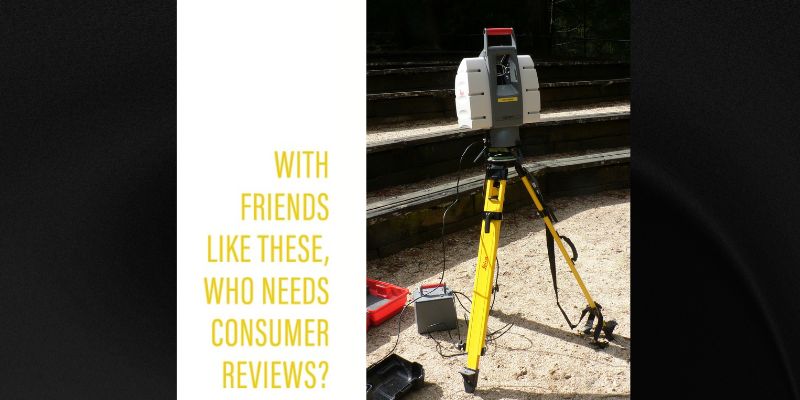By Matt Kowalski
Likely, everyone can agree that we prefer to make informed decisions when spending our hard-earned money. If it is a car, computer, or the pen that I used to write this you can find a consumer report about it.
Don’t believe me? Search “pen consumer report.” You will not only find Consumer Reports, but you will also find articles like “the best pens of 2023” and similar headlines. Almost everything has been compared to its competitors and thoroughly examined. I say “almost” because when you are in the market for a laser scanner, the bountiful forest of comparison data that exist for other products more resembles a barren wasteland.
Sure, you can find people’s opinions and lots of marketing material, but actual side-by-side comparisons? Good luck. You might be thinking you can use the manufacturer data sheets to do your own comparisons. Maybe. First, you’ll need to go to each manufacturer’s website, find the data sheet, enter your info for access, and start examining—only to find out that all manufacturers use different metrics to market their instruments.
Fortunately for us, there is hope. In the past few years, organizations like the Unites States Institute of Building Documentation (USIBD) and the folks at Go-Geomatics have started taking matters into their own capable hands. Beginning with the TLS scan off at Geo Week 2023 these organizations have performed several events with the sole purpose of placing usable information in consumer hands.
Both organizations are creating events where different instruments can be run through “real world” environments and tested thoroughly. Respectably, neither organization has tried to declare a winner or a “best of.” Instead, they provide comparable specs and, in some cases, even the point clouds.

Some results from the lidar scan off at the 2023 Go Geomatics Expo held last November.
“In a growing niche industry without standards in place, the reality capture landscape can be daunting and seem much like the wild west—full of snake oil salesmen and enough hyperbole to drown a fish,” says Chris Kercheval of the USIBD. “To help the new to industry consumer, the USIBD Laser Scanning Committee is dedicated to providing the valuable materials needed for a true comparison of products and workflows, maximizing the normalization of information and allowing for the greatest return on investment through condensed spec sheets and true one-to-one data sets to fully highlight the strengths and weakness of the products available.”
He goes on: “Without this, the available options for comparison are limited as compared to more established industries like automotive, which we are using as a foundation. Although we do not name a winner, we provide the information and test results that allow each consumer to pick the winner for their business and their clients, and we feel this is the basis for true industry growth and adoption of reality capture.”
Carina Butterworth, professor of geomatics at Southern Alberta Institute of Technology and co-coordinator of the S.L.A.M. Scan Off at the Go-Geomatics Expo in Calgary in November 2023, believes that this type of comparison is essential to help both the technology companies and service companies know what tool is best for the right job.
“Tech companies are able to market their laser scanners better when comparisons like this are made, where service companies have a better idea which laser scanner is better for the specific jobs they are taking on,” Butterworth said.
Future participation in these comparisons will develop an informed consumer market of laser scanning and help everyone maintain the integrity of the Geomatics industry by using the optimal tool.
During Geo week 2023 the USIBD performed a live “scanner shoot-out.” Its goal was to run as many scanners through the same environment and conditions as possible. For this event, targets were set up at distances of five, 10, and 20 meters. Boards were placed against the targets that had examples of different materials we encounter while scanning in the field.
Each manufacturer performed a low resolution, medium resolution, and a high-resolution scan from the base location. All data was then geo referenced and placed into a third-party software for analysis. In the analysis each sensor was judged by point spacing/resolution, time of acquisition, ease of transport and several other metrics. You can find the full report on the USIBD’s website www.usibd.org.
During the Go Geomatics Expo 2023 in Calgary, Alberta, volunteers from several organizations performed a Simultaneous Localization and Mapping (SLAM) “scan-off.” This event was directed at mobile and Slam scanners and aimed at testing for drift as well. Drift is a common trajectory issue with these types of scanners where inaccuracies accumulate over time, leading to a deviation between the estimated and actual position of the device.
For this event, a course 50 meters wide and 186 meters long was planned out. This course covered both interior and exterior scanning. Targets were placed along the course and used to geo-reference the data. After all the data was analyzed a point cloud density and a point cloud confidence were assigned to each sensor.
When compared to other product markets, consumer data for scanners is still a barren wasteland, but thanks to the efforts of these organizations, we can see an oasis of information forming. I can’t help but feel that, much like Mad Max and his gasoline truck, these events give us hope for a brighter, more informed, future.
Matt Kowalski has more than 10 years of experience in layout management and laser scanning to provide innovative solutions and services to our clients and partners. His passion to push the boundaries of technology and delivering high-quality results in every project led him to co-found LiDAholics consulting firm.

